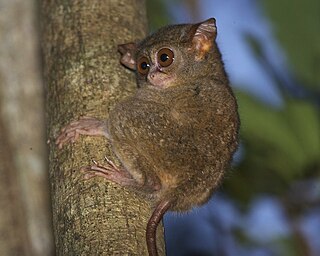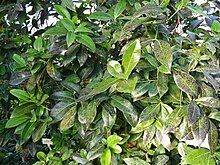
Lauraceae, or the laurels, is a plant family that includes the true laurel and its closest relatives. This family comprises about 2850 known species in about 45 genera worldwide. They are dicotyledons, and occur mainly in warm temperate and tropical regions, especially Southeast Asia and South America. Many are aromatic evergreen trees or shrubs, but some, such as Sassafras, are deciduous, or include both deciduous and evergreen trees and shrubs, especially in tropical and temperate climates. The genus Cassytha is unique in the Lauraceae in that its members are parasitic vines. Most laurels are highly poisonous.

Persea is a genus of about 150 species of evergreen trees belonging to the laurel family, Lauraceae. The best-known member of the genus is the avocado, P. americana, widely cultivated in subtropical regions for its large, edible fruit.

Apollonias is a genus of flowering plants belonging to the laurel family, Lauraceae. The genus includes from one to 10 species of evergreen trees and shrubs, depending on circumscription; recent studies have limited the genus to just one species, with the others transferred to Beilschmiedia.

Laurus azorica, the Azores laurel or Macaronesian laurel, is a small, evergreen tree in the laurel family (Lauraceae), found only on the Azores island group in the North Atlantic.
Persea brenesii is a species of plant in the family Lauraceae. It is endemic to Costa Rica.
Persea conferta is a species of plant in the family Lauraceae. It is endemic to Ecuador. Its natural habitat is subtropical or tropical moist montane forests.
Persea glabra is a species of plant in the family Lauraceae. It is endemic to Brazil.

Persea indica is a large, evergreen tree in the laurel family (Lauraceae), native to humid uplands on Madeira and the Canary Islands in the North Atlantic. It belongs to the genus Persea, a group of evergreen trees including the avocado. It is threatened by habitat loss.
Persea julianae is a species of plant in the family Lauraceae. It is endemic to Suriname.

Persea liebmannii is a species of plant in the family Lauraceae. It is native to Mexico, Guatemala, and Belize.

Persea lingue, synonyms including Persea meyeniana, is an evergreen tree or shrub in the laurel family (Lauraceae), found in Argentina and Chile. It belongs to the genus Persea, a group of evergreen trees including the avocado. P. lingue was historically used in leather production, and is currently threatened by habitat loss.
Persea obtusifolia is a species of plant in the family Lauraceae. It is found in Costa Rica and Panama.
Persea pyrifolia is a species of plant in the family Lauraceae. It is found in Brazil and Mexico.
Persea ruizii is a species of plant in the family Lauraceae. It is endemic to Peru.
Povedadaphne is a genus of plants in the family Lauraceae, with a single species, Povedadaphne quadriporata. They are evergreen "lauroid" trees belonging to the tropical laurel forest habitat, a type of cloud forest in Costa Rica, in Central America.

Tarsius is a genus of tarsiers, small primates native to islands of Southeast Asia. Until 2010, all tarsier species were typically assigned to this genus, but a revision of the family Tarsiidae restored the generic status of Cephalopachus and created a new genus Carlito.

Persea borbonia or redbay is a small, evergreen tree in the laurel family (Lauraceae), native to the southeastern United States. It belongs to the genus Persea, a group of evergreen trees including bays and the avocado. Persea borbonia has several common names including tisswood, scrubbay, shorebay, and swampbay.











